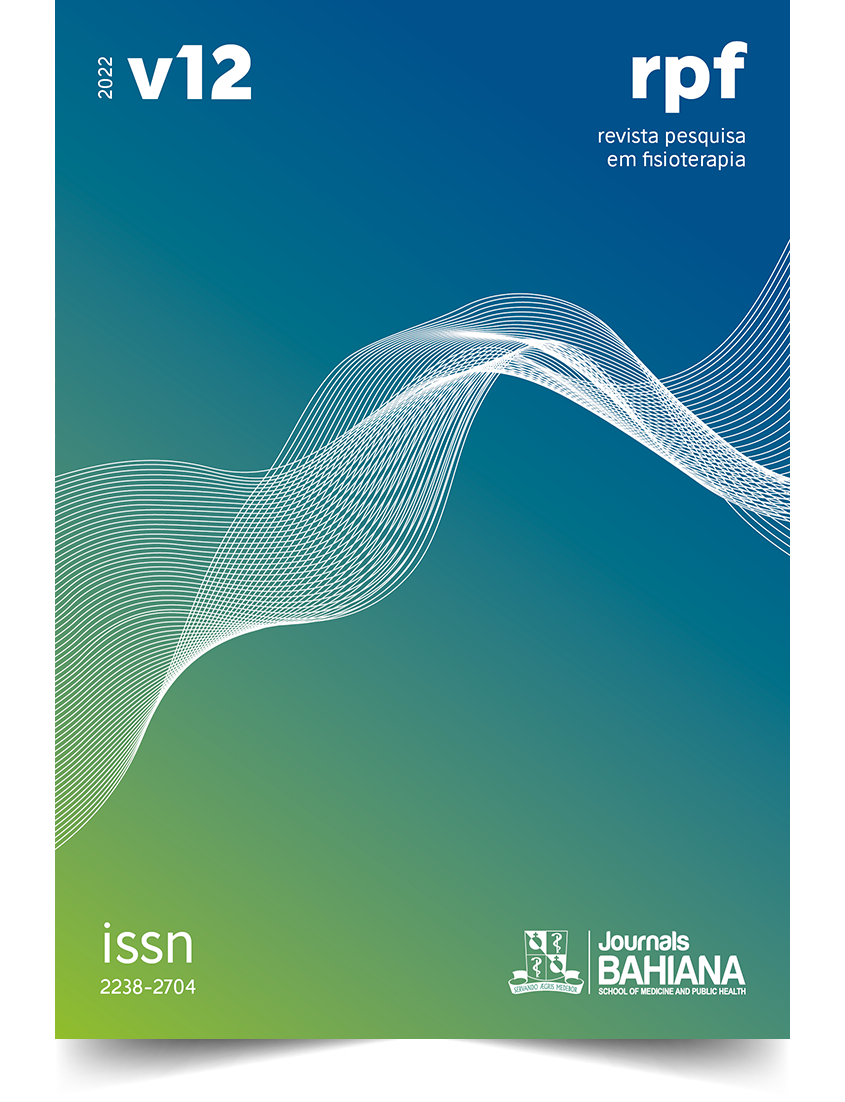Desempenho do teste de sentar e levantar de trinta segundos na população geriátrica da comunidade: um estudo transversal
DOI:
https://doi.org/10.17267/2238-2704rpf.2022.e4600Palavras-chave:
Índice de massa corporal, Geriátrico, Teste sentar e levantarResumo
OBJETIVO: Encontrar os valores de referência para o teste de sentar e levantar de 30 segundos e estudar a correlação das medidas antropométricas com o teste na população indiana geriátrica residente na comunidade. MATERIAL E MÉTODOS: 136 indivíduos com idade >60 anos foram recrutados neste estudo transversal e observacional. O estudo foi realizado na Índia. Após a triagem inicial, as medidas antropométricas foram registradas. Em seguida, foi realizado o teste de sentar e levantar de 30 segundos. RESULTADOS: Os valores normais da década para o teste foram relatados como (média±DP): 60-70 anos (10,2±3,6), 71-80 anos (9,5±3,4) e 81-90 anos (8,5±5,2). Idade, altura, circunferência da cintura e circunferência do quadril foram significativamente associadas aos valores do teste. CONCLUSÃO: Os valores normais para o teste de sentar e levantar de 30 segundos para a população geriátrica da comunidade foram relatados como média ± DP 10,0 ± 3,7. Os fatores antropométricos devem ser levados em consideração ao realizar o teste de sentar e levantar de 30 segundos em ambientes clínicos.
Downloads
Referências
(1) Beaudart C, Rolland Y, Cruz-Jentoft AJ, Bauer JM, Sieber C, Cooper C, et al. Assessment of Muscle Function and Physical Performance in Daily Clinical Practice. Calcif Tissue Int. 2019;105(1):1-14. https://doi.org/10.1007/s00223-019-00545-w
(2) Goda A, Murata S, Nakano H, Matsuda H, Yokoe K, Mitsumoto H, et al. Temporal Patterns in Performance of the 30 Second Chair-Stand Test Evince Differences in Physical and Mental Characteristics Among Community-Dwelling Older Adults in Japan. Healthcare (Basel). 2020;8(2):146. https://doi.org/10.3390/healthcare8020146
(3) Bohannon RW, Bubela DJ, Magasi SR, Wang YC, Gershon RC. Sit-to-stand test: Performance and determinants across the age-span. Isokinetic Exerc Sci. 2010;18(4):235-240. https://doi.org/10.3233/ies-2010-0389
(4) Applebaum EV, Breton D, Feng ZW, Ta AT, Walsh K, Chassé K, et al. Modified 30-second Sit to Stand test predicts falls in a cohort of institutionalized older veterans. PLoS One. 2017;12(5):e0176946. https://doi.org/10.1371/journal.pone.0176946
(5) Jones CJ, Rikli RE, Beam WC. A 30-s chair-stand test as a measure of lower body strength in community-residing older adults. Res Q Exerc Sport. 1999;70(2):113-119. https://doi.org/10.1080/02701367.1999.10608028
(6) Millor N, Lecumberri P, Gómez M, Martínez-Ramírez A, Izquierdo M. An evaluation of the 30-s chair stand test in older adults: frailty detection based on kinematic parameters from a single inertial unit. J Neuroeng Rehabil. 2013;10(86). https://doi.org/10.1186/1743-0003-10-86
(7) Bodilsen AC, Juul-Larsen HG, Petersen J, Beyer N, Andersen O, Bandholm T. Feasibility and inter-rater reliability of physical performance measures in acutely admitted older medical patients. PLoS One. 2015;10(2):e0118248. https://doi.org/10.1371/journal.pone.0118248
(8) McAllister LS, Palombaro KM. Modified 30-Second Sit-to-Stand Test: Reliability and Validity in Older Adults Unable to Complete Traditional Sit-to-Stand Testing. J Geriatr Phys Ther. 2020;43(3):153-158. https://doi.org/10.1519/jpt.0000000000000227
(9) Vaidya T, Chambellan A, Bisschop C. Sit-to-stand tests for COPD: A literature review. Respir Med. 2017;128:70-77. https://doi.org/10.1016/j.rmed.2017.05.003
(10) Le Berre M, Apap D, Babcock J, Bray S, Gareau E, Chassé K, et al. The Psychometric Properties of a Modified Sit-to-Stand Test with Use of the Upper Extremities in Institutionalized Older Adults. Percept Mot Skills. 2016;123(1):138-152. https://doi.org/10.1177/0031512516653388
(11) Bohannon RW. Reference values for the five-repetition sit-to-stand test: a descriptive meta-analysis of data from elders. Percept Mot Skills. 2006;103(1):215-222. https://doi.org/10.2466/pms.103.1.215-222
(12) Nakazono T, Kamide N, Ando M. The Reference Values for the Chair Stand Test in Healthy Japanese Older People: Determination by Meta-analysis. J Phys Ther Sci. 2014;26(11):1729-1731. https://doi.org/10.1589/jpts.26.1729
(13) Wang J, Thornton JC, Russell M, Burastero S, Heymsfield S, Pierson Jr RN. Asians have lower body mass index (BMI) but higher percent body fat than do whites: comparisons of anthropometric measurements. Am J Clin Nutr 1994;60(1):23-28. https://doi.org/10.1093/ajcn/60.1.23
(14) McCarthy EK, Horvat MA, Holtsberg PA, Wisenbaker JM. Repeated chair stands as a measure of lower limb strength in sexagenarian women. J Gerontol A Biol Sci Med Sci. 2004;59(11):1207-1212. https://doi.org/10.1093/gerona/59.11.1207
(15) Netz Y, Ayalon M, Dunsky A, Alexander N. 'The multiple-sit-to-stand' field test for older adults: what does it measure?. Gerontology. 2004;50(3):121-126. https://doi.org/10.1159/000076769
(16) Woldegebriel AG, Fenta KA, Aregay AB, Aregay AD, Mamo NB, Wubayehu TW, et al. Effectiveness of Anthropometric Measurements for Identifying Diabetes and Prediabetes among Civil Servants in a Regional City of Northern Ethiopia: A Cross-Sectional Study. J Nutr Metab. 2020;2020:8425912. https://doi.org/10.1155/2020/8425912
(17) Vaish H, Ahmed F, Singla R, Shukla DK. Reference equation for the 6-minute walk test in healthy North Indian adult males. Int J Tuberc Lung Dis. 2013;17(5):698-703. https://doi.org/10.5588/ijtld.12.0474
(18) Whitrow MJ, Harding S. Ethnic differences in adolescent lung function: anthropometric, socioeconomic, and psychosocial factors. Am J Respir Crit Care Med. 2008;177(11):1262-1267. https://doi.org/10.1164%2Frccm.200706-867OC
(19) Izquierdo M, Merchant RA, Morley JE, Anker SD, Aprahamian I, Arai H, et al. International Exercise Recommendations in Older Adults (ICFSR): Expert Consensus Guidelines. J Nutr Health Aging. 2021;25(7):824-853. https://doi.org/10.1007/s12603-021-1665-8
(20) Podder V, Nagarathna R, Anand A, Patil SS, Singh AK, Nagendra HR. Physical Activity Patterns in India Stratified by Zones, Age, Region, BMI and Implications for COVID-19: A Nationwide Study. Ann Neurosci. 2020;27(3-4):193-203. https://doi.org/10.1177/0972753121998507
(21) Demura S, Yamada T. Height of chair seat and movement characteristics in sit-to-stand by young and elderly adults. Percept Mot Skills. 2007;104(1):21-31. https://doi.org/10.2466/pms.104.1.21-31
(22) Lockie RG, Ruvalcaba TR, Stierli M, Dulla JM, Dawes JJ, Orr RM. Waist Circumference and Waist-to-Hip Ratio in Law Enforcement Agency Recruits: Relationship to Performance in Physical Fitness Tests. J Strength Cond Res. 2020;34(6):1666-1675. https://doi.org/10.1519/jsc.0000000000002825
(23) Palve SS, Palve SB. Impact of Aging on Nerve Conduction Velocities and Late Responses in Healthy Individuals. J Neurosci Rural Pract. 2018;9(1):112-116. https://doi.org/10.4103/jnrp.jnrp_323_17
(24) Mohammed R, Basha ASK, Jungade S. Influence of Age, Gender, and Body Mass Index on Balance and Mobility Performance in Indian Community-Dwelling Older People. Phys Occup Ther Geriatr. 2021;39(2):144-156. https://doi.org/10.1080/02703181.2020.1818909
(25) Schorr M, Dichtel LE, Gerweck AV, Valera RD, Torriani M, Miller KK, et al. Sex differences in body composition and association with cardiometabolic risk. Biol Sex Differ. 2018;9(28). https://doi.org/10.1186/s13293-018-0189-3
Downloads
Publicado
Edição
Seção
Licença
Copyright (c) 2022 Mehar Sheoran, Hina Vaish

Este trabalho está licenciado sob uma licença Creative Commons Attribution 4.0 International License.
Esta obra está licenciada com uma Licença Creative Commons Atribuição 4.0 Internacional.



